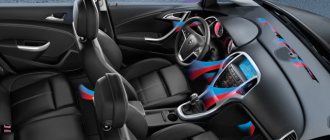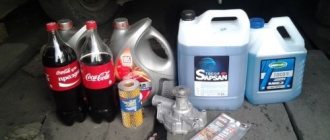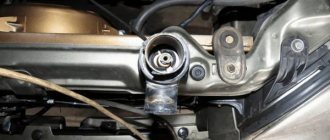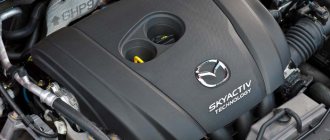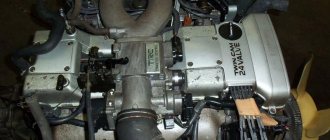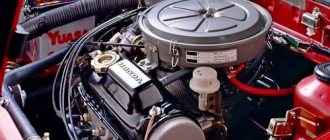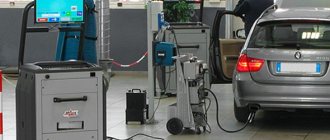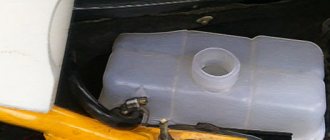Left air
This expression is used by drivers when they discover that “foreign” air has entered the intake system. This “uninvited guest” entered through microcracks in the gaskets of the intake manifold, throttle valve, and injector seals.
Hence the conclusion - the intake tract is depressurized. “Left” air enters the combustion chamber. This leads to a lean fuel mixture and its incorrect formation. The result is intermittent engine starting, difficulties in acceleration, poor power development, and valve knocking. There are also other unpleasant moments - poor braking, high fuel consumption. To complete this picture, all contaminants from the air mass enter the combustion chamber in addition to the filter.
Replacing a radiator on Nexia
- The first step is to drain the coolant; to do this, unscrew the plug at the bottom of the radiator.
- Disconnect the hoses from the radiator; to do this, use pliers to compress the protruding “tendrils” of the clamp that holds the hoses. After this, carefully move and pull out the hoses from their seats.
- Now you need to unscrew the bolt securing the radiator support from the body; at this stage you will need a “10” key.
- Having unscrewed the second support, you can pull the radiator up with careful movements. The lower radiator mounting supports are simply inserted through a rubber gasket that wears out over time. Check these rings; if they are cracked or stiff, it is recommended to replace them with new ones.
- Rinse the radiator thoroughly with water and dry it. If the radiator is damaged, it must be replaced.
- Install the radiator in reverse order, then fill with coolant.
To prevent antifreeze leaks, a thin layer of silicone sealant must be applied to the joints of the hoses - this will prevent leaks at the joints. It is also recommended to check the radiator for leaks (see below how to check).
After filling the coolant, it is necessary to remove air from the cooling system. To do this, start the engine and wait until it heats the coolant to more than 50-60 degrees. Then open the cap of the expansion tank and press on the thick hose coming from the radiator. Thus, air bubbles will rise into the expansion tank and exit according to the laws of physics.
When the path is leaky
This problem is relevant for both types of engines - gasoline and diesel. They are equally sensitive to the presence of “extra” air. Therefore, checking the inlet tightness is necessary if certain symptoms are detected. This is manifested by an electronic error, increased fuel consumption, constant engine overheating, tripping, and unstable idling.
First you need to check the most vulnerable places - tubes and hoses, intake manifold gasket, idle air control, throttle gasket, brake booster, adsorber. After all, the tightness of systems is inextricably linked with the concept of a “well-running motor.” Therefore, the appearance of signs of malfunction in one unit will disrupt the coordinated operation of the entire machine.
Engine cooling system functions
Maintaining optimal engine temperature is the main task performed by the Volkswagen Passat B3 cooling system. At critical temperatures, the gaps in moving elements decrease. If the malfunction is not corrected in time, accelerated wear of the internal combustion engine will begin, which entails the risk of parts jamming, self-ignition of gasoline, or detonation. Maintaining a constant engine temperature is not the only task of the cooling system.
Cooling system. Photo source: https://www.drive2.ru/l/507591743059788015/
Main functions:
- cooling the turbocharger air flow;
- reduction of engine warm-up time;
- heating the air in the ventilation and air conditioning system;
- lowering the engine oil temperature;
- cooling the transmission fluid in the automatic transmission.
The operating temperature range of the motor is 92-100 °C. Depending on the load and environment, the equipment smoothly transfers heat to the atmosphere through directed air flow or coolant. It is important to avoid sudden changes in temperature, as condensation deposited on the walls will dilute the oil, which will impair performance and increase component wear.
Verification methods
To determine the cause, the intake system is diagnosed. Even with a routine inspection, you can identify defects if you know the weakest points of your car. visually determine the malfunction if you smell antifreeze, smudges form on the engine and under the car, and coolant appears in the oil. But some types of breakdowns cannot be detected by a simple inspection. This will require special equipment and certain skills.
You can diagnose the intake mode using a smoke generator . The device is connected to the complex under test. A stream of smoke under pressure is injected into the duct, seeping into the depressurization areas. Thus, checking the intake for leaks with smoke will help identify even the slightest leak.
To determine deviations in the operation of the intake tract, special measuring instruments are used. However, experts do not always agree on the accuracy of the readings of these devices, so auto mechanics suggest using a comprehensive assessment of the current situation.
Experienced drivers determine depressurization of areas by ear . To do this, gasoline is sprayed onto the suspected leak areas. If liquid gets on the damaged area, it is sucked in instead of air, making a characteristic sound. The location of the leak is determined by this hissing sound. Experienced drivers note that this method is the most accurate and reliable.
Cooling System Maintenance
Previous119120121122123124125126127128129130131132133134Next
During maintenance of the cooling system, the coolant filling is checked, there are no leaks, the tension of the fan drive belts is checked and adjusted, the radiator mounting, the operation of the shutters, the fan, the water pump, the operation of the thermostat and the steam-air valve are checked, and scale and sludge are periodically removed from the system.
The engine cooling system is filled with low-freezing liquid, and in the summer it can be filled with water; the KamAZ-740 engine system is filled only with low-freezing liquid “TOSOL-A-40M” or “TOSOL-A-65M”.
During ETO, the fluid level in the system, the tightness of connections, and whether there are any fluid leaks are checked.
During TO-1, in addition to the work provided for by the ETO, the fastenings of the fan blades and bracket, the water pump, the radiator and its lining, the fastening and operation of the blinds are checked, the fan and water pump bearings are lubricated.
During TO-2, in addition to the listed work, the operation of the thermostat and the steam-air valve of the radiator cap, and the fastening of the distribution tank are checked.
With CO, the engine cooling system is flushed. In preparation for the winter period of operation, the operation of the pre-heater and cabin heater is checked.
The main malfunctions of the cooling system are overheating or undercooling of the engine, and coolant leakage.
Engine overheating is possible due to an insufficient amount of coolant in the system, slipping or breaking of the fan and water pump drive belts, the thermostat or radiator shutter sticking in the closed position, or the deposition of a large layer of scale on the walls of the cooling jacket.
Engine overcooling can occur if the thermostat or blinds do not close completely or there is no insulating cover in the winter.
Coolant leakage is possible as a result of damage to the sealing gaskets, loosening of the bolts or nuts securing the cylinder head, hose clamps, wear of the seals, or damage to the radiator.
The fluid level in the system must be constantly checked and, if necessary, brought up to normal, otherwise the fluid circulation in the system will be disrupted and the engine will begin to overheat. Water is poured into the radiator up to the edge of the steam pipe, and low-freezing liquid (antifreeze) is poured 5-7 cm lower, since it increases in volume when heated.
“TOSOL-A-40M, A-65M” is poured into the expansion tank to the level of special marks.
The fan belt tension is checked using a ruler or a special device (Figure 24.2). When pressing the belt with a force of 3-4 kgf (30-40 N), its deflection should be 10-20 mm. On most engines, fan belt tension is adjusted by moving the alternator or tension pulley.
1 – crankshaft pulley; 2 – nut; 3 – bar; 4 – generator pulley; 5 – compressor pulley; 6 – bolt; 7 – fan and water pump pulley; 8 – drive belt for fan and power steering pump; 9 – scale for measuring force; 10 – scale for measuring belt deflection; 11 – fixture bar; 12 – power steering pump pulley; 13 – bracket for the power steering pump; 14 – bracket bolts
Figure 24.2 — Checking the tension of engine drive belts
To check the operation of the thermostat, it is removed from the engine and lowered into a vessel with water, which is heated, measuring the temperature at the beginning and full opening of the thermostat valve. The valve of a working thermostat begins to open at 68-72 °C. Full opening of the valve occurs at 81-85 °C.
The operation of the thermostat can be checked by touch. The upper radiator tank should begin to heat up only when the water temperature in the cooling system is about 70 ° C and above (from the moment the thermostat valve begins to open). The faulty thermostat is replaced.
To remove scale, corrosion products and sludge from the cooling system, it is washed with various solutions, mixtures or water. If scale deposits are minor, it is recommended to flush the system with a stream of clean water; in this case, the radiator and cooling jacket of the engine block are washed separately in the direction opposite to the normal circulation of fluid in the system. To protect the radiator from damage, the water pressure when flushing it should be no more than 1 kgf/cm2 (100 kPa).
If scale deposits are large and the engine overheats, then solutions and mixtures are used that destroy scale consisting of insoluble salts. The cooling system of gasoline engines with blocks or heads made of aluminum alloys cannot be washed with alkaline or acidic solutions. For them, it is recommended to use a saturated solution of trisodium phosphate (100 g of trisodium phosphate per 1 liter of water), which is poured into the system at the rate of 50-100 cm3 of solution per 10 liters of water for two to three days. After draining the solution through the lower hose, thoroughly rinse the radiator and cooling jacket separately with clean water.
To flush the engine cooling system of UAZ vehicles, a solution of chromium (4-8 g per 1 liter of water) is used. The solution is poured into the system, and the engine runs on it for a month. Then the solution is drained and the system is washed with hot water. It must be borne in mind that a solution with a chromium concentration of less than 3 g per 1 liter of water has increased corrosiveness.
Chrompik is poisonous, so the solution is prepared with a gas mask and rubber gloves.
Previous119120121122123124125126127128129130131132133134Next
Date added: 2016-09-26; views: 23516; ORDER A WORK WRITING

